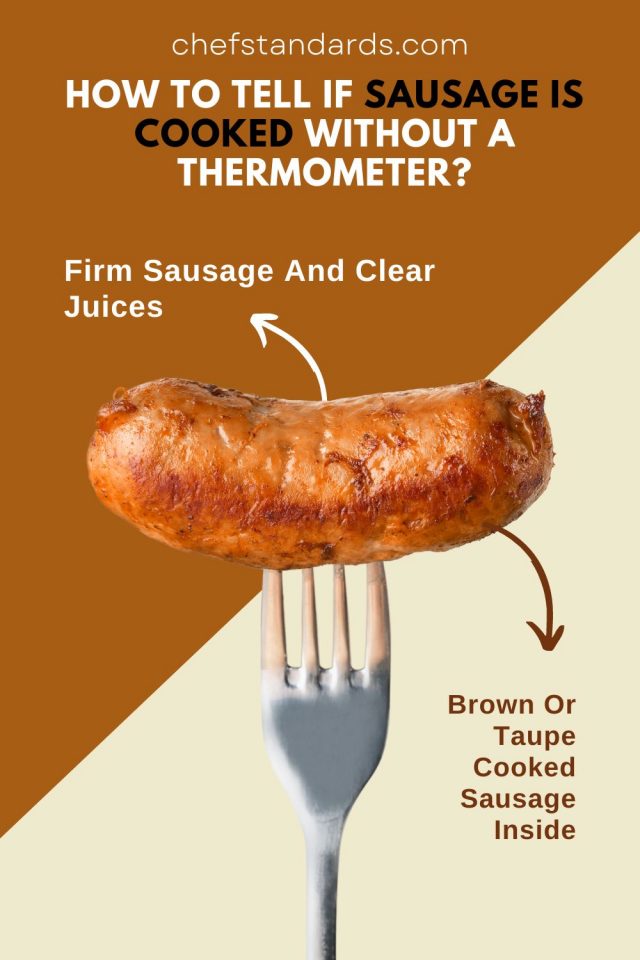How To Tell If Sausage Is Cooked: A Complete Guide + Tips!
Is there anything more satisfying than the sizzle of sausage hitting the pan, filling your kitchen with a savory aroma? Knowing precisely when your sausage is perfectly cooked is the key to unlocking this culinary delight, ensuring both safety and the most enjoyable flavor experience.
Achieving that perfect balance of flavors and textures when cooking sausage hinges on a crucial skill: knowing precisely when it's done. Whether you're grilling, pan-frying, or simmering, understanding the signs of doneness is paramount. This guide will equip you with the knowledge you need to confidently cook sausage every time, avoiding undercooked risks and preventing overcooked disappointments.
Sausage, in its myriad forms from the robust Italian sausage to the delicate chicken varieties presents a delightful challenge in the kitchen. Unlike a steak, where visual cues of doneness are readily apparent, sausage requires a more careful approach. Undercooked sausage can harbor harmful bacteria, posing a risk to your health. Overcooked sausage, on the other hand, can become dry, tough, and lose its delicious, juicy appeal. That's why we'll cover methods to recognize if the sausage is fully cooked, by looking at the color, texture, and temperature.
Before we delve into the specifics, let's clarify a few fundamental principles. The internal temperature is your best friend when cooking sausage. A meat thermometer is the most reliable tool to ensure your sausage has reached a safe and delicious level of doneness. However, other indicators, like texture and color, can also provide valuable clues.
Let's start with a simple question: How do you know for sure when your sausage is perfectly cooked? Here are some time-tested methods to take the guesswork out of the process.
The Meat Thermometer: Your Most Trusted Ally
The cornerstone of safe and delicious sausage cooking is the meat thermometer. This simple tool offers the most precise and dependable way to determine when your sausage has reached its safe internal temperature. For most types of sausage, the magic number is 160F (71C). Chicken and turkey sausage, due to their higher susceptibility to bacterial growth, require a slightly higher temperature of 165F (74C).
To use a meat thermometer correctly, insert it into the thickest part of the sausage link or patty, avoiding any bone or casing. Ensure the thermometer probe isn't touching the pan or grill, as this can provide a false reading. Wait a few seconds for the temperature to stabilize, and consult the recommended internal temperature guidelines.
Texture: The Subtle Touch
Beyond the thermometer, a tactile approach can also tell you if your sausage is cooked. Fully cooked sausage should feel firm to the touch, but not rubbery or spongy. It should have a slight give, but resist pressure. A raw or undercooked sausage will feel soft and pliable.
For chicken and turkey sausage, the texture is particularly crucial. Because these meats can dry out more quickly, it's easy to overcook them. Aim for a firm, slightly bouncy feel when touched, indicating that the sausage is cooked through.
Color: A Visual Guide
While not a foolproof method on its own, the color of sausage can offer valuable visual cues. A done sausage will typically have a deep brown or taupe exterior, and the interior will be consistently grey or brown. Undercooked sausage will often exhibit pink or reddish hues in the center. This is especially true for sausages containing pork.
However, color can be misleading. Some sausages, particularly those with added nitrates or nitrites, may retain a pink color even after being fully cooked. For this reason, don't rely on color alone. Always use the meat thermometer in conjunction with the visual cues.
Juices: A Clear Indicator
If you don't have a meat thermometer, you can still get a sense of how cooked the sausage is by observing the juices. When you slice into a fully cooked sausage, the juices should run clear, not pink or red. Pink or bloody juices indicate the sausage is undercooked.
Cooking Methods and Timings: A General Overview
The cooking method you choose will influence the precise cooking time. Here are some general guidelines:
- Pan-Frying: Place sausage links or patties in a cold pan. Add a small amount of water or oil, and cook over medium heat, turning frequently, until browned on all sides and the internal temperature reaches the recommended level. This generally takes about 15-20 minutes.
- Grilling: Grill sausage over medium heat, turning occasionally, until browned and cooked through. This typically takes 15-25 minutes.
- Baking: Preheat the oven to 375F (190C). Place sausage on a baking sheet and cook for 20-30 minutes, turning once, until cooked through.
- Boiling: Place sausage in a pot of simmering water. Bring to a boil and then reduce heat and cook for 15-20 minutes
Remember, these are just general guidelines. Cooking times can vary depending on the thickness of the sausage, the specific cooking method, and the equipment used. Always use a meat thermometer to verify the internal temperature.
Types of Sausage and Their Specifics
Different sausage varieties have unique characteristics that can affect cooking. Knowing the type of sausage you're working with can help you tailor your cooking approach for the best results.
Italian Sausage:
Italian sausage, often made with pork, is a popular choice. The most important thing is to make sure the internal temperature is at 160F (71C) to make it safe to eat.
Chicken Sausage:
Chicken sausage, needs a bit more caution. Aim for an internal temperature of 165F (74C) to ensure it's fully cooked. Test the sausage in its thickest part. The exterior should be well-browned, and the juices should run clear.
Turkey Sausage:
Turkey sausage requires the same internal temperature as chicken sausage, at 165F (74C). Due to the leanness of turkey, it is crucial not to overcook it. Monitor the internal temperature with a thermometer.
Smoked Sausage:
Smoked sausage, already cured and smoked, typically requires only reheating. Cook it to an internal temperature of 165F (74C) to ensure that it's heated through. Remember, if the sausage has been stored, it can pick up bacteria after some time. A good rule of thumb is to cook the smoked sausage on medium to low heat, but only long enough to bring the internal temperature to 165F.
Cured Sausage:
Many sausages undergo curing processes which can affect their color and texture. Cured sausages often retain a pinkish hue even after being fully cooked. Refer to the internal temperature guide.
How to Know if Sausage Has Gone Bad
Beyond determining if the sausage is cooked, it's important to be able to recognize when it has gone bad. This is essential for food safety.
- Smell: A sour or off smell is a primary indicator of spoilage. If your sausage has an unpleasant odor, discard it immediately.
- Appearance: Discoloration, such as a greenish or grayish tint, can signal spoilage. The sausage casing may also appear slimy.
- Texture: If the sausage crumbles easily or feels excessively soft, it may be spoiled.
Safe Handling and Storage
Proper handling and storage of sausage are essential to maintain its quality and safety. Keep raw sausage refrigerated at 40F (4C) or below. Cooked sausage can be stored in the refrigerator for up to four days. If the sausage has been at room temperature for more than two hours, it should be discarded.
Tips and Tricks
- Don't Overcrowd the Pan: When pan-frying, don't overcrowd the pan, as this can lower the temperature and prevent even cooking.
- Use a Low to Medium Heat: Cooking sausage at too high a temperature can cause the casings to burst, releasing juices and drying out the sausage.
- Let it Rest: Once cooked, let the sausage rest for a few minutes before slicing or serving. This allows the juices to redistribute, resulting in a more tender and flavorful product.
- Turning the Sausage: Always remember to turn the sausage after about 10 minutes or halfway through the cooking process. If you dont do this, the sausages wont be evenly cooked.
Addressing Common Concerns: Pink Sausage and Beyond
It's natural to have questions, and the world of sausage cooking is no exception. Here are some common concerns.
- Is it Okay if My Sausage is Slightly Pink? In some cases, yes. Certain sausages, especially those with added nitrates or nitrites, may retain a pink hue even after being fully cooked. The best indicator is the internal temperature. If it has reached the recommended level, the sausage is safe to eat.
- Can Color Tell You if Sausage is Cooked? Color can be a useful guide, but don't rely on it as your sole indicator. A done sausage will be brown or taupe all the way through, while an underdone sausage might be pink or red inside.
The Art of the Perfect Sausage
Mastering the art of cooking sausage is about combining knowledge with a touch of intuition. Always start with a reliable meat thermometer. Pay attention to the texture and color of your sausage. With practice, you'll become adept at recognizing the subtle cues that signal perfect doneness, resulting in delicious, safe, and satisfying meals.
By following these guidelines and learning the nuances of different sausage types, you'll be well on your way to creating sausage dishes that are not only safe but truly exceptional in flavor and texture.
So, fire up the grill, heat up the pan, or preheat the oven, and get ready to enjoy the wonderful world of perfectly cooked sausage!
| Attribute | Details |
|---|---|
| Safe Internal Temperature (Pork & Beef Sausage) | 160F (71C) |
| Safe Internal Temperature (Chicken & Turkey Sausage) | 165F (74C) |
| Key Indicators | Firmness to the touch, Clear Juices, Deep Brown or Taupe Exterior, Grey/Brown Interior |
| Cooking Method (Pan-Frying) | 15-20 minutes, medium heat, turn frequently |
| Cooking Method (Grilling) | 15-25 minutes, medium heat, turn occasionally |
| Cooking Method (Baking) | 20-30 minutes at 375F (190C), turn once |
| Cooking Method (Boiling) | 15-20 minutes, Simmering Water |
| Storage (Raw) | Refrigerate at 40F (4C) or below |
| Storage (Cooked) | Refrigerate up to 4 days |
| Discard | Sausage at room temperature for more than two hours should be discarded |
| Reference Website | USDA Food Safety and Inspection Service |
- Sotwe Twitter Viewer Turkish Chat Trends Explained
- Kinsey Schofield Her Husband Life Love Career Insights

3 Brilliant Methods On How To Tell If Sausage Is Cooked

Sausage 101 How To Tell If Sausage Is Cooked?

3 Brilliant Methods On How To Tell If Sausage Is Cooked